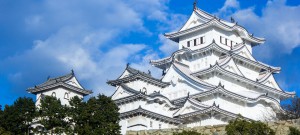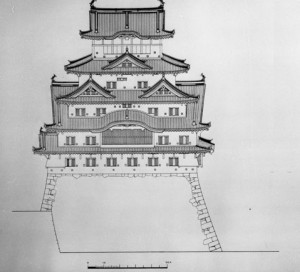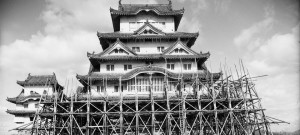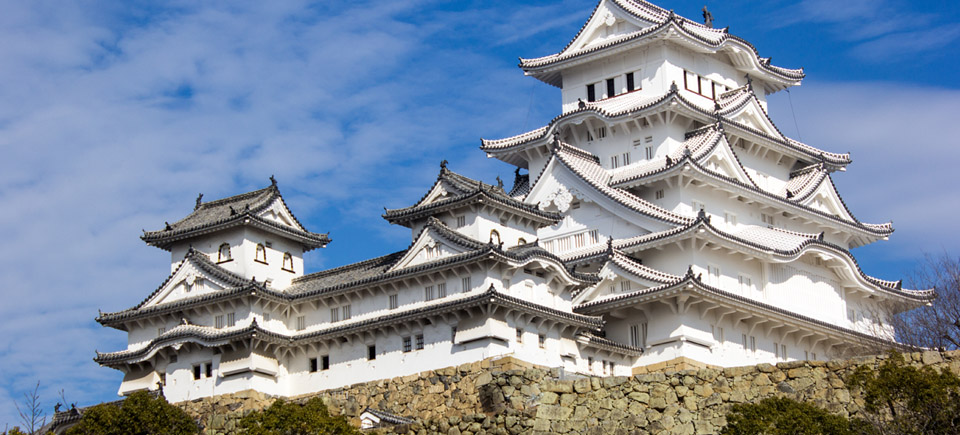Feature
The White Heron Spreads its Wings
At last, after a restoration project spanning five years, the iconic Himeji Castle is reopening to the public in full. That it has survived at all, however, is quite the tale of luck.
Himeji Castle is predicted to welcome a whopping two million visitors this year after its post-restoration reopening on March 27th. Perched upon a hill where its towers can be seen for miles, the picturesque fortress is nicknamed Shirasagi-jo (“White Heron Castle”) or Hakuro-jo (“White Egret Castle”) because of its brilliant, white exterior and unique tower structuring. It wields a commanding view of the city and leaves a lasting impression on all who journey to see it. Film aficionados will instantly recognize it from the James Bond movie You only Live Twice (1967), and from Akira Kurosawa’s Kagemusha (1980), and Ran (1985). This World Heritage Site is the epitome of the feudal Japanese castle and the largest, best-preserved of all its counterparts across the nation. The newly-restored structure is truly a sight to behold, but the stories of how this now national treasure survived multiple demolition plans, earthquakes, and even a World War II bomb are as surprising as the castle is enchanting.
History and Style
 Himeji Castle itself has gone through many incarnations dating back to 1333, being rebuilt and remodeled by various daimyo (feudal lords). The current form we see today is over 400 years old. After the the pivotal battle of Sekigahara in 1600, which saw power shift to Tokugawa Ieyasu and the eventual beginnings of the Edo Period (1603–1868), Ieyasu awarded the castle to his son-in-law, Ikeda Terumasa. In 1601 Terumasa overhauled the castle and rebuilt it completely, finishing it in 1609. The new fortress was in the nowiconic Azuchi-Momoyama style.
Himeji Castle itself has gone through many incarnations dating back to 1333, being rebuilt and remodeled by various daimyo (feudal lords). The current form we see today is over 400 years old. After the the pivotal battle of Sekigahara in 1600, which saw power shift to Tokugawa Ieyasu and the eventual beginnings of the Edo Period (1603–1868), Ieyasu awarded the castle to his son-in-law, Ikeda Terumasa. In 1601 Terumasa overhauled the castle and rebuilt it completely, finishing it in 1609. The new fortress was in the nowiconic Azuchi-Momoyama style.
The new design was in response to the introduction of firearms in Japan in 1543. It is distinctively characterized by a musha-gaeshi (large stone base), with large, complex maru (baileys) and a daitenshu (main keep). These changes gave significant protection and tactical advantage to the daimyo and their armies. Himeji-jo is the perfect personification of this design, standing today as the finest example of 17th-century Japanese architecture. It is a designated kokuhou (a national treasure of Japan) and was named a UNESCO World Heritage Site in 1993.
In 1869, the government auctioned the castle off and a man named Mr. Kanbe bought it for 23-and-a-half yen. A bargain even in those days, the amount is estimated at around ¥200,000 in today’s currency.
Structure and Defenses
As formidable as it is elegant, Himeji Castle was built incorporating a plethora of tricks and defensive structures. One of the keys to the castle’s defenses is its elaborate maze system, which possesses many disorienting pathways. With 84 gates (21 of which still exist) and three moats (only the inner moat exists now) working in tandem with the baileys and outer walls, an enigmatic labyrinth was created that is known to still confuse tourists today, even with signs posted!
One deceptive gate in particular gives the appearance that the main tower is very close, when in fact following the path that winds through it takes you away from the main keep. Conversely, another gate provides a correct pathway to the central tower, but will deceive an unwitting visitor by seemingly taking them down and away from it.
Roughly 1,000 sama (loopholes) are littered around the castle for archers and armed guards with matchlocks to harass any would-be intruders, as well as a variety of ishiotoshi (angled chutes) from which stones or boiling water could be cast down on the enemy. This explains why, in its more than 400-year history, no one dared to attack Himeji Castle.
The Lucky Castle
At least three strokes of mighty good luck have fallen upon Himeji Castle at crucial points in its past when circumstances almost rendered it solely to the history books – torn down, demolished, or bombed into non-existence.
The ushering in of the new Meiji Period (1868–1912) signaled the end of the significance of Japanese castles. During the Meiji era, surviving castles were considered great burdens to upkeep because of the cost. The government also wanted these prestigious symbols of the former regime to be removed and forgotten, ordering all castles to be sold and demolished. Many castles were torn down and Himeji Castle was slated to share this same fate.
In 1869, the government auctioned the castle off and a man named Mr. Kanbe bought it for 23-and-a-half yen. A bargain even in those days, the amount is estimated at around ¥200,000 in today’s currency. He was a developer and planned to clear the land, but found it was too expensive to level the giant castle.
“The white heron turned into a white elephant,” joked volunteer guide Kenji Miyazaki.
The castle narrowly escaped destruction again a few years later in 1871. During this year, some of the corridors and gates were leveled to make room for modern military barracks, and there were plans to expand these on the castle grounds. If not for the last-minute intervention of Colonel Nakamura Shigeto, who convinced the army chief to leave it, the castle would have been torn down.
Himeji-jo escaped ruin yet again during World War II when Himeji was heavily bombed with much of the city being destroyed. A fire bomb was dropped directly on Himeji Castle, and somehow, the bomb did not go off. This White Heron Castle prevailed once more while so much around it perished.
The castle even stood up to the Great Hanshin Earthquake in 1995, receiving very little damage.
“Despite it being such a powerful earthquake, even the bottle of sake on the altar at the top floor remained in place. The sake was an offering to the gods, so the gods’ sake was OK,” Mr. Miyazaki smiled.
Who says you only live twice?
The latest restoration project, the Heisei Restoration, began in October 2009 concentrating on roof replacement, re-applying the white plaster, and installing anti-seismic reinforcement. At ¥2.3 billion (Himeji city putting up roughly ¥805 million (35%) with the rest coming from the government), no expense has been spared. The main focus has been on protecting and preserving cultural assets.
Getting There
Himeji Castle’s main keep will be opened to the public from Fri, Mar 27
• Access: JR Himeji Stn, Central Exit, 10-min walk
• Admission: (From Mar 27) Adults ¥1,000, Kids ¥300
• Open: 9:00am–4:00pm (gate closes at 5:00pm)
• Tel: 07-9285-1146
生まれ変わった白鷺城
5年余り続いた「平成の修理」を終え、ついに姫路城が一般公開の日を迎える。 この美しい城郭は、奇跡のような幸運の導きで幾多の危機を生き延びてきた
修復工事明けの再公開となる3月27日以降、姫路城は今年だけで 200万人もの来客を見込んでいいる。丘の上に建ち、何キロも先か ら威容が望める天下の名城。端麗な姿、明るい白壁、ユニークな天 守閣の構造から、「白鷺城」の異名をとっている。街を見下ろす城の 姿は、訪れた者すべての脳裏に焼き付けられるだろう。映画ファン なら、ジェームズ・ボンドの『007は二度死ぬ』(1967年)や、黒澤明 の『影武者』(1980年)と『乱』(1985年)などを思い出すかもしれ ない。世界遺産に登録され、封建時代の日本式城郭の象徴として、 その規模も保存状況の良さも他の城の追随を許さない。修復され た姫路城に一見の価値があるのはもちろんだが、その運命もまた 劇的だ。解体計画、地震、第2次世界大戦での爆撃など、幾多の危 機を生き延びてきた激動の歴史があるのだ。
歴史と様式
1333年の建設以来、姫路城は当時の大名によって何度か再建さ れて様式も変化している。現在の姿になったのは400年以上前の こと。1600年に関ヶ原の戦いで天下を取った徳川家康は、次女の 夫にあたる池田輝政に播磨国を譲った。輝政は1601年に姫路城 の大改修に着手し、1609年に完成を見る。これが安土桃山様式で 建てられた現代の姫路城である。
新しい姫路城の建築様式は、1543年に銃が渡来したことを踏ま えて設計された。武者返しと呼ばれる巨大な石垣がひとつの特徴 で、複雑な構造を持つ大天守などの建物から構成される。この改築 で、大名と武士たちは防衛力を戦略的に増強した。姫路城は17世 紀の日本建築を現代に伝える象徴として国宝に指定され、1993年 にはユネスコ世界遺産にも登録されている。
構造と防衛力
 畏敬の念さえ抱かせる優美な城内には、手の込んだ防御設備が数 多く採用されている。城内の構造で重要なのは、余所者が行き先を 見失うように設計された複雑な迷路システムだ。門は84箇所(うち 21箇所が現存)、堀は3箇所(現存は内堀のみ)。城内は天守群や 外壁を中心に不思議な迷宮が形作られ、案内の標識があっても現 代の観光客を迷わせるほどである。
畏敬の念さえ抱かせる優美な城内には、手の込んだ防御設備が数 多く採用されている。城内の構造で重要なのは、余所者が行き先を 見失うように設計された複雑な迷路システムだ。門は84箇所(うち 21箇所が現存)、堀は3箇所(現存は内堀のみ)。城内は天守群や 外壁を中心に不思議な迷宮が形作られ、案内の標識があっても現 代の観光客を迷わせるほどである。
門からして、人を欺くようにできている。天守閣の間近に見える 門をくぐると、通路はくねくねと曲がって城の中心から遠ざけられ る。逆に、天守閣にすんなり行ける門もあ る。しかしその門から続く道は、一見すると 城を下りて天守閣から遠ざかっていくよう に錯覚させられるのだ。
また城全体には、射撃用に作られたおよ そ千個の「狭間(さま)」という窓が張り巡ら され、恐ろしい火縄銃が配備されている。 侵入者に頭上から石や熱湯を浴びせる、さ まざまな形状の「石落とし」もある。これな ら400年以上もの間、姫路城の攻略を試み た者がいないのも当然だ。
1869年、政府が姫路 城を競売にかけると、 神戸清次郎という男が 23円50銭で落札し た。これは当時として も破格の安値で、現在 の貨幣価値でわずか 20万円ほどだ。
幸運な名城
そんな姫路城にも、崩壊、解体、爆撃などに よって消え去り、歴史書だけの存在になっ てしまいそうな状況が何度かあった。ぎりぎ りの危機から救い出された幸運は、少なく とも今までに3回ある。
明治時代になると、日本の城はみな崖っ ぷちに追いやられた。前時代の遺物は、保 存コストだけがかかる無用の長物と見なさ れたのである。古い封建体制の象徴であ る城を、取り払って忘れさせたい。そう考 えた日本政府は、廃城令を出してすべての 城の解体または売却を命じた。日本中で城 が破壊され、姫路城にも同じ運命が待ち構 えていた。
 1869年、政府が姫路城を競売にかける と、神戸清次郎という男が23円50銭で落 札した。これは当時としても破格の安値で、 現在の貨幣価値でわずか20万円ほどだ。 土地の開発業者だった彼はここを更地にし たかったが、この巨城を解体するには莫大 な費用がかかることに気づいた。
1869年、政府が姫路城を競売にかける と、神戸清次郎という男が23円50銭で落 札した。これは当時としても破格の安値で、 現在の貨幣価値でわずか20万円ほどだ。 土地の開発業者だった彼はここを更地にし たかったが、この巨城を解体するには莫大 な費用がかかることに気づいた。
「白鷺が白象になったというわけです よ」と、ボランティアで姫路城のガイドを務 める宮崎健二さんが冗談を言う。
1871年、姫路城は再び絶体絶命のピン チを免れることになる。近代的な兵舎を建 てるため、この年にいくつかの門と通路が 取り壊された。もし中村重遠大佐が最後に 介入して城を存置するよう陸軍を説得して いなければ、姫路城は解体の憂き目にあっ ていたことだろう。
さらに姫路城は、第2次世界大戦で姫路 市がほぼ壊滅するほどの激しい爆撃を受け たときにも、廃墟となるのを免れた。爆弾は 姫路城の上に直接落とされたが、どういう わけか不発弾となったのだ。麗しき白鷺城 は、街が滅亡しつつある最中で、またしても 奇跡的に生き延びたのである。
1995年の阪神大震災でも、城の被害は 最小限のものに留まった。
「あれだけの強い揺れだったのに、最 上階の祭壇に置かれた酒瓶さえ倒れずに 済みました。お神酒は神様への捧げ物だか ら、ご加護があったのでしょうか」と、宮崎 さんは笑う。
この城には、いったいいくつの命がある のだろう。
2009年10月に始まった「平成の修理」 では、屋根の修理、漆喰の塗り直し、耐 震補強に重点が置かれた。23億円の予 算全額(姫路市が約8億円を拠出し、残 りを日本政府が負担)が修理に費やされ ている。修理の主な目的は、文化財の保 全である。
行き方
姫路城の主要部分は、3月27日(金)か ら一般公開される。
• アクセス: JR姫路駅中央口から徒 歩10分
• 入場料: 大人1,000円、子供300円(3 月27日より)
• 開館時間: 午前9:00~午後4:00(午 後5:00閉門)
• 電話:07-9285-1146













